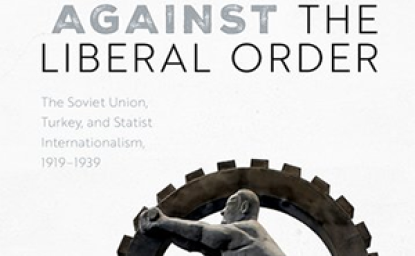Assessing the Damage: the June 1967 Czech Delegation to Egypt

CWIHP e-Dossier No. 16
Author: Guy Laron, a post-doctoral fellow at Tel-Aviv University. He has recently completed his dissertation on Israeli-Egyptian relations in the 1950s and is currently engaged in research on the Soviet involvement in the Six-Day War. His publications include Cold War International History Project Working Paper No. 55, Cutting the Gordian Knot: The Post-WWII Egyptian Quest for Arms and the 1955 Czechoslovak Arms Deal.
On June 26th, 1967, a plane carrying a high-level Czechoslovak delegation of state and party officials landed on a stretch of boiling tarmac near Cairo. The timing of its arrival could not have been more dramatic: it had arrived at Egypt barely two weeks after a coalition of Arab armies which included Egypt, Syria, Jordan, and Iraq was soundly defeated by Israel in a war that had lasted only six days. Not only was the tarmac boiling; the whole Arab world was in the midst of a political maelstrom. The following document1 recounts the conversations that the Czechoslovaks had with Egyptian President Gamal Abd al-Nasser and with other high-level officials and senior officers. It also reveals their impressions of what they had seen and heard in Egypt.
Shortly after the humiliating defeat suffered by Egypt during the June 1967 War – also known as the Six-Day War – delegations from all over the Eastern bloc hurried to Cairo in an attempt save the pro-Soviet regime of Gamal Abd al-Nasser. After the Israeli army destroyed the Egyptian army in less than six days, Nasser's regime seemed to be economically, militarily, and ideologically bankrupt. Still, the Soviets regarded their relations with Egypt highly and considered it the most important country in the Third World.2 Indeed, shortly after the war, the chairman of the Soviet Communist party, Leonid Brezhnev, explained to a colleague that although Nasser had shown himself capable of making serious errors of judgment, everything should be done to support him and stabilize his regime.3 Accordingly, Soviet, Polish, East-German, Bulgarian, and Czechoslovak delegations of high-level officials rushed to Cairo in order to understand what had happened and to find out what could be done.
On the economic level, the concern was to give Nasser enough support so that the supply of food in Egypt would not be interrupted. On the military level, however, things were more complicated. On the one hand, the Egyptians badly needed a fresh supply of weapons to compensate for materiel lost during the war. On the other hand, logic, as well as a natural sense of national pride, made the Egyptians suspect that the onus of blame should not fall solely on their shoulders, and that something was afoul with the Soviet weapons and doctrine. The Soviets and the Czechoslovaks tried to reassure them that this was not the case, but at the same time they were anxious to find out why their weapon systems had malfunctioned. For while the Arabs wallowed in the disgrace of their defeat by minuscule Israel, the Soviets were extremely worried because the war in the Middle East seemed to prove that Western doctrine and weaponry, which Israel used, could trounce Soviet doctrine and weaponry.
The Czechoslovaks were uniquely situated to provide answers to these questions. Ever since the large arms deal that they concluded with Egypt in September of 1955 – a deal that broke the Western monopoly on arms supply to the region4 – the Czechoslovaks had maintained close relations with the Egyptian army and trained Egyptians officers in facilities in Czechoslovakia and Egypt.
To be sure, the Egyptian army had been routed before. In 1956, at the height of the Suez crisis, British, French, and Israeli forces attacked Egypt in retribution for Nasser's decision to nationalize the Suez Canal Company. In response, the Egyptian army fled from Sinai to the Western bank of the Suez Canal. Yet, that dismal performance might have been explained away by the fact that the Egyptian army did not have sufficient time to absorb the weapons it had started to receive from the Soviets and the Czechoslovaks at the end of 1955. The same could not be said about 1967. The Egyptian army, reinforced by Czechoslovak and Soviet arms and training, had had almost ten years to prepare but failed miserably at the crucial moment. Who was to blame – the Soviet weapons or the Egyptian army?
The document provides answers to these and other questions, and enables us to have a rare glimpse into the Soviet and Arab mindsets following the war. It joins a growing body of evidence emerging from East European archives, which deepens our understanding of the Soviet bloc's reaction to the outcomes of the June 1967 War.5 Earlier CWIHP publications have shown that documents stored in the archives of the former East European allies of the USSR could prove to be a "side door" to Soviet foreign policy documents, which are still classified in Moscow.6 This document proves that they can do the same to secrets still locked in Arab archives, which are essentially inaccessible to researchers interested in the post-World War II period. It also shines a light on one of the least-studied aspects of the Israeli air attack at the onset of the war: Israel's ability to use electronic warfare to neutralize the Soviet-made Egyptian defense systems.
To be sure, some of what Valdimir Koucki, the head of the delegation and secretary of the Czechoslovak Communist Party Politburo, told the Egyptians, conforms to what Soviet leader Leonid Brezhnev said in his speeches of June and July of 1967.7 The Soviet sense that the Arabs had committed a fatal tactical error by confronting Israel at that particular point in time was reflected in Koucki's advice to Egyptian President Gamal Nasser "to conduct a realistic policy and not to try to reach out to the unachievable and illogical." Like Brezhnev, Koucki, after meeting with Nasser and other Egyptian officials, was convinced that Egypt was on the verge of relinquishing its non-aligned foreign policy in favor of a firmer bond with the Soviet bloc. In his report, Koucki strongly recommended that Czechoslovakia encourage this Egyptian change rather than cling to a "wait and see" approach. Moreover, Koucki feared that certain elements within the Egyptian elite would use a tepid Soviet response to the Egyptian predicament to discredit the regime's pro-Soviet orientation.
The Koucki-Nasser conversation also makes clear that the latter had not completely relinquished his non-alignment policy, and while Koucki was heaping insults on the leaders of Algeria, Nasser maintained that they were still part of the "progressive" camp.
Egypt's dire need of military and economic aid, as reported by Brezhnev in his speeches, naturally became another topic for discussion in the conversations between the Czechoslovaks and the Egyptians and, in-between, the document allows us also to see Nasser's peculiar negotiating technique in action. He spent much time during his meeting with Koucki, expounding what might be termed a reverse Domino Theory. Nasser maintained that if the "imperialists" succeeded in toppling his and other Arab "progressive regimes," they would then proceed to mount a vigorous attack against the East European satellites. In that way he tried to prove that it was in the interest of the Soviet bloc to help him. All this was good and well, but when the conversation reached its unpleasant part, Nasser went out of the room, leaving his Vice, Zakaria Muhi al-Din, the humiliating job of naming the sums which Egypt was in need of and haggling with the Czechoslovaks over the amount of aid they would be willing to give.
The Czechoslovaks' close acquaintance with the Egyptian army encouraged the Egyptian officers, who talked to members of the Czechoslovak delegation, to provide a detailed explanation of their defeat. Their explanation highlights another rarely-studied aspect of the Israeli surprise attack on June 5th, 1967. The Israeli planes were able to evade the Soviet-made Egyptian aerial-defense systems not only by "flying very close to the ground," as the current literature has it,8 but also by deploying sophisticated electronic warfare. Two Israeli Votour planes flew at high altitude through the Sinai sky on June 5th, carrying systems whose electronic signals suppressed the activity of the Soviet-made SA-2 missiles. Thus they created corridors within the Egyptian air defense, through which Israeli planes could pass in relative safety.9 The attached document offers, for the first time, a description of the effects of Israeli electronic warfare on Egyptian radar and SA-2 operators on June 5th. The Egyptian account underlines that the use of electronic warfare by the Israelis was far more important than the altitude at which the Israeli planes were able to fly. That these reports aroused great concern in the Warsaw Pact can be gleaned form a Stasi working paper, written after the war, which analyzed the military campaign conducted by Israel. It emphasized Israel's successful use of electronic warfare and instructed Stasi agents to find out whether NATO forces and the West German army were capable of applying the same methods against the armed forces of East Germany.10
We do know, however, that another Egyptian claim, mentioned in this document (as well as in other Egyptian publications from that period), to the effect that the American intelligence ship USS Liberty helped the Israelis during their surprise attack, had been proven wrong.11 The Liberty, which the Israelis had bombed during the war, was not even near the scene of battle on that day.12 However, the Egyptians' confusion is quite understandable. In the weeks leading up to the war, American planes, surveying the Sinai to gather intelligence, used similar techniques to suppress the Egyptian aerial defense systems.13 The ever-suspicious Egyptians attempted to connect the dots and inferred, erroneously, that the Americans were behind the Israeli successes on June 5th.
Another interesting Egyptian claim which appears in the report is that the Israelis had also used Bedouin tribes living in Sinai to block the Egyptian army's radio communication. According to the Egyptians, the Bedouins were equipped with small radio disruption devices, which were able to completely block radio communications between headquarters and the units on the ground in the first hours of the Israeli attack. During the attack, Egyptian land forces moved out of their initial positions, and the Egyptian headquarters were unable to catch up with the constantly changing situation on the ground until the war ended. Had the radio and radar operators, the Egyptians conceded, been better-trained, they would have been able to overcome the difficulties, caused by the Israelis, by simply changing frequencies. They were not, and the consequences for the Egyptian army were disastrous.
The Czechoslovaks were not completely swayed by this presentation. Having good contacts within the Egyptian army, the Czechoslovaks were able to gather fairly detailed information on the lax behavior of the high-ranking Egyptian officers before the war: the commander of the air force had failed to put his forces on high alert, the commander of the ground forces left Sinai when the hostilities started, and even after the tensions on the Egyptian-Israeli border had reached new heights, mid-level officers were allowed to leave Sinai, take vacations in Cairo, and transfer the command to junior officers. In addition, according the Czechoslovaks, the commanders of the army were not effective in coordinating the activities of the air force, the ground forces, and the navy, with the result that each force fought independently.
The inadequacy of the Soviet weapons in comparison to the Western arms used by Israel does not figure in this report as a reason for the Egyptian defeat, although members of the Czechoslovak delegation were aware that such allegations were rife among Egyptian officers. Instead, the Czechoslovak analysis emphasized an alleged lack of tactical knowledge on the part of the Egyptians. The representatives of the Czechoslovak army therefore used the opportunity to convince their Egyptian counterparts to allow more Czechoslovak instructors into Egypt in order to continue training soldiers and officers in the effective use of weapons. The Egyptians, in their desperation, were most forthcoming in their response.
Another interesting aspect of the document is the strong insinuations that Egyptian Vice-President and Chairman of the Arab Socialist Union (ASU), Ali Sabri, made with regard to the role played by the ASU, Egypt's sole political party, in the events of June 9th. On that day, Nasser submitted his resignation to the Egyptian public, taking responsibility for the defeat. Within minutes, millions of weeping Egyptians poured into the streets of Egypt's main cities to plead with Nasser to stay.14 It is clear, however, from what Ali Sabri told the Czechoslovak delegation, that these demonstrations were only partly spontaneous and that the ASU worked behind the scenes to stage this mass protest. Indeed, such was the impression of the American embassy in Cairo at the time.15
Although Egypt was soundly defeated, the impression of the Czechoslovak delegation was that the country would be able to recover from its devastating loss. Nasser seemed beaten down, but not broken, and his grip on power seemed to be firm. The Egyptian crowds were peaceful and friendly. Daily life in Cairo, the Czechs observed, had returned to normal two weeks after the war. The ineffective and corrupt officers who had lost the war were being replaced by younger officers, graduates of military schools in Czechoslovakia and in the Soviet Union. Perhaps the most graphic demonstration of the changes in the Egyptian army in the aftermath of the war was the removal of the portrait of Abd al-Hakim Amer, the former supreme commander of the Egyptian armed forces, from the office of the new air force commander, and its replacement with a picture of Marshall Vereshinin, the commander of the Soviet air force. With the support of Czechoslovakia and the Soviet Union, the army was also replenishing its arsenal. If one looked for an answer as to how the army which was trounced so decisively in 1967 was able to surprise the Israeli Defense Forces and fight effectively in 1973, this Czechoslovak report offers at least partial answers.
Click here to read a report on the visit of the Czechoslovak President's special envoy, V. Koucki, to the UAR.
Footnotes to the e-Dossier:
1) The author is grateful to Karel Sieber, (Czech TV archive) for his help in obtaining and translating the document. Research in Prague was enabled by a generous travel grant from CWIHP. The author would like to thank Prof. Eyal Zisser, head of the Dayan Center, and Prof. Ehud Toledano, head of the History School, for making a post-doctoral year in Tel-Aviv University possible.
2) See for example Memo of Conversation between Chairman of the Polish Communist Party, Wladislaw Gomulka and First Secretary of the Soviet Communist Party, Leonid Brezhnev on 14 October 1966 in: Andrzeja Paczkowskiego, ed., Tajne Dokumenty Biura Politycznego: PRL-ZSSR 1956-1970, [Secret Documents of the Polish Politburo of the Polish Communist party, The Polish Peoples Republic-Soviet Union relations, 1956-1970], pp. 402-403; "Comments on the Soviet Foreign Policy in the Last Quarter, Political Report no. 16", 6 May 1967, RG TO-T SSSR, 1965-69, Box 12, folder 8 (311), A MZV [Czech Foreign Ministry Archive], Prague, the Czech Republic.
3) Diary entry for 17.6.67 in Petro Shelest, Da Ne Sudimi Budete, (Moscow: edition q, 1995), p. 283.
4) Guy Laron, "Cutting the Gordian knot: The Post WWII Egyptian Quest for Arms and the 1955 Czech Arms Deal", Cold War International History Project, The Woodrow Wilson International Center for Scholars, working paper #55, (Washington, DC, February 2007); Timothy Naftali and Aleksandr Furshenko, Khrushchev's Cold War, (New York: W.W. Norton, 2006), pp. 57-82.
5) V.V. Naumkin ed. Blizhni Vostochni Konflikt (Moscow, 2003) Vol. II, e-dossiers 8 & 13 on the CWIHP website: www.cwihp.org.
6) See James Hershberg's introduction to CWIHP e-dossier no. 13 "The Soviet Bloc and the Aftermath of the June 1967 War: Selected Documents."
7) Uri Bar-Noi CWIP e-dossier 8, "The Soviet Union And The Six-Day War: Revelations From The Polish." James Hershberg, CWIHP e-dossier 13, "The Soviet Bloc and the Aftermath of the June 1967 War: Selected Documents."
8) See, for example, Michael Oren, Six Days of War, (New York: Presidio Press, 2003), p. 170.
9) Danny Shalom, Kera'am Be-yom Bahir, [Like a Bolt from the Blue] (Rishon Le-Zion, Israel: Bavir, 2002), pp. 215-220.
10) "The aggression committed by Israel against the Arab countries and the American Global Strategy", 30 August 1967, MfS, ZAIG 4624, the Stasi Archive, Berlin, Germany.
11) Elie Podeh, "The Lie That Won't Die: Collusion, 1967", Middle East Quarterly, (Winter, 2004) [available also at: http://www.meforum.org/article/587].
12) James Bamford, Body of Secrets (New York: Anchor books, 2002), pp. 181-190.
13) Amin Hewedi, 50 A`man min al-awasif, [50 Years of Storms] (Cairo: Markaz al-Ahram, 2002), pp.408-422.
14) Kirk J. Beattie, Egypt During the Nasser Years, (Boulder, CO.: Westview, 1994), p. 211.
15) "Live, Caesar, Live! – Nasser Stages Support Demonstrations", 15 June 1967, Cairo to State Dept., airgram no. A-698, POL 15-1 UAR, Central Foreign Policy Files, 1967-1969, box 2554, RG 59, United States National Archives, College Park, MD., USA.
Author

Senior Lecturer, The Hebrew University of Jerusalem, Israel

Cold War International History Project
The Cold War International History Project supports the full and prompt release of historical materials by governments on all sides of the Cold War. Read more




